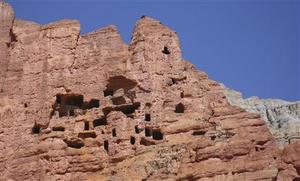Jon Cartwright
PhysicsWebSat, 05 May 2007 05:12 UTC
Being the closest planet to the Sun, you might think Mercury would be the most likely rocky planet in the Solar System to have a molten core, but for the past three decades physicists have not been quite so sure. By taking radar measurements of Mercury using ground-based radio telescopes, however, physicists in the US and Russia claim to have proved that the variation in the planet's spin rate is indeed characteristic of a molten core. Their work also lends weight to the idea that Mercury, like Earth, produces its magnetic field in the molten core through dynamo action (Science 316 710).
Despite its 400 °C surface temperatures, physicists originally predicted that Mercury's small mass - about 5% that of the Earth - would have allowed its core to cool down enough to solidify long ago. But their predictions became much less certain in the 1970s after NASA's Mariner 10 spacecraft flew by the planet and detected a small internal dipole magnetic field. Although some claimed that the field could have been a fossil of an earlier one "frozen" into the crust, others maintained that this was very unlikely, and that dipole magnetic fields in terrestrial planets are normally a result of the convection of molten iron producing a dynamo.
Paleontologists unearthed a flesh-eating dinosaur some 150 million years old in southern Argentina with all its joints in place, the first time such a beast has been dug up so intact, one of the finders told AFP today.
The seven-metre tall, two-legged dinosaur, dubbed the Condorraptor, was found fossilised with parts of its jaw and head showing in rock near the village of Cerro Condor in Patagonia, at a site where paleontologists had been working for five years.
"It is an unprecedented discovery. It is the first time in the world that a carnivorous dinosaur of the Middle Jurassic period has been found fully jointed," said Pablo Puerta, a paleontologist at the Egidio Feruglio museum in the town of Trelew.
Gopal Sharma
ReutersFri, 04 May 2007 12:53 UTC
Explorers have discovered a series of caves decorated with ancient Buddhist paintings, set in sheer cliffs in Nepal's remote Himalayan north, leaving archaeologists excited and puzzled.

|
| ©Reuters
|
| Newly discovered caves are seen in the hills of Mustang in Nepal May 3, 2007.
|
The number of calls made on mobile phones has fallen for the first time, according to new research.
The figures suggest that the novelty of constantly being in touch is finally starting to fade.
Chandra Bill
WPTVThu, 03 May 2007 16:50 UTC
You've heard of the Loch Ness Monster, the Creature from the Black Lagoon.
The sea serpents of legend, right?
A local diver says he's found something not even the Smithsonian can identify and it's right off the shores of Juno Beach.

|
| ©Dennis Burke
|
Rice University scientists today revealed a breakthrough method for producing molecular specks of semiconductors called quantum dots, a discovery that could clear the way for better, cheaper solar energy panels.
AFPThu, 03 May 2007 10:18 UTC
The fossilised bones of Australia's largest dinosaur went on display Thursday, with experts predicting the find will rewrite what is known of the country's prehistoric past.
The two dinosaurs, nicknamed Cooper and George by researchers, are part of the titanosaur family that lived about 100 million years ago, and at 25 metres (yards) long were among the largest animals to ever roam the Earth.
Ben McConville
ABC / APThu, 03 May 2007 04:56 UTC
Like a plot from "The Da Vinci Code," a team of code breakers claims to have found music hidden for 500 years in intricate carvings at the church where author Dan Brown set the climax of the best-selling book.
Father and son team Thomas and Stuart Mitchell say they deciphered a musical code hewn into stone cubes on the ribs supporting the ceiling of Rosslyn Chapel in the village of Roslin, near Edinburgh.
"Breaking the code was a true eureka moment. It's like we have been given a compact disc from the past," said Stuart Mitchell, 41, a music teacher from Edinburgh. "But unlike the fiction of 'The Da Vinci Code,' this is a tangible link to the past."
The music has been recorded, and will get its official premiere in the chapel May 18.
Musical experts reserved judgment, but did not dismiss the Mitchells' theory.
Police discovered five swords in the bedroom of a Clements High School senior whose home they searched after getting complaints about a 3-D computer "shoot-'em-up" game map the student designed, which depicted a portion of the school.
That information surfaced in a Fort Bend Independent School District Police Department report released Tuesday, and was confirmed by several district officials who also revealed other details about the case for the first time.
The student, whose name has not been released, was not arrested or charged by FBISD police, however, he was removed from Clements and transferred to M.R. Wood Alternative Education Center several days ago. Officials said he also complied with a police order to delete the game and game maps from his computer.
Australia - Scientists and Australian beer maker Foster's are teaming up to generate clean energy from brewery waste water - by using sugar-consuming bacteria.
The experimental technology was unveiled Wednesday by scientists at Australia's University of Queensland, which was given a $115,000 state government grant to install a microbial fuel cell at a Foster's Group brewery near Brisbane, the capital of Queensland state.
The fuel cell is essentially a battery in which bacteria consume water-soluble brewing waste such as sugar, starch and alcohol.
The battery produces electricity plus clean water, said Prof. Jurg Keller, the university's wastewater expert.